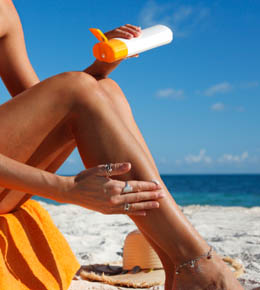After a Chicago winter that has seemingly extended into May, it’s no surprise we’re craving some Vitamin D.
To prep for sunshine, now’s the perfect time to reevaluate your skin protection. The supermarket shelves are stocked with different sunscreens, but what should you be looking for?
Chemical vs. Physical
Sun protection is classified into two types: chemical and physical. Chemical sunscreens contain special ingredients that act as filters and reduce ultraviolet radiation penetration to the skin. These are often colorless, maintain a thin visible film on the skin and usually contain UVB and UVA absorbing chemicals.
Physical sunscreens (sunblocks) consist of ingredients such as titanium dioxide and zinc oxide, which physically block ultraviolet radiation (UVR). Sunblocks provide broad protection against both UVB and UVA light and don’t wash off as easily.
Knowing whether a sunscreen is physical or chemical won’t necessarily tell you whether it’s effective. Rather, always choose a sunscreen that:
- Has an SPF of 30 or higher.
- Blocks both UVA and UVB rays. This is indicated on the label as multi spectrum, broad spectrum or UVA/UVB protection.
- Contains the ingredients avobenzone (for chemical sunscreen) or zinc oxide (for physical sunscreen).
Not Just for Sunny Days
“Wear sunscreen year-round, even on cloudy days,” says Leah Toppel, MMS, PA-C and member of the Society of Dermatology Physician Assistants. “Apply at least 20 minutes before sun exposure and reapply after swimming or every four hours. Don’t forget your ears and lips.”
Unopened sunscreen generally has a shelf life of three years, but replace opened bottles each year.
While sunscreens range in price, there’s no proven evidence that more expensive sunscreens offer greater protection over a less costly alternative. According to Toppel, “Choosing a sunscreen is truly a matter of personal preference and finding one that offers optimal protection.” Regarding new technologies in sunscreen development, Toppel explains, “Today we’re seeing micronized formulations of sunscreen, resulting in products that are more comfortable on the skin, transparent and noncomedogenic.”
Finally, Toppel advises, “Sunscreen application should be something that becomes second-nature—like brushing your teeth or wearing a seatbelt. Stay out of tanning beds. If you want tan skin, spray tans are a much safer alternative. There’s no such thing as a safe tan and you’ll thank yourself later!”
Some of our favorites
All-around: Blue Lizard, $22.49
Unscented/Organic: Badger unscented sunscreen SPF 30, $14
Tinted: Kate Somerville SPF 55 Serum Tinted Sunscreen, $45
For kids: California Baby No Fragrance SPF 30+ Sunscreen Lotion, $19.99
For face: La Roche Posay Anthelios, $29.50
Cellex-C Suncare Sunscreen & Moisturizer SPF 30, $35
For acne-prone: Noncomedogenic Neutrogena Age Shield + Repair SPF 55, $9.99
For sensitive skin: Clarins UV Plus Day Screen High Protection SPF 40, $38
Leah Toppel, MMS, PA-C is a member of the Society of Dermatology Physician Assistants and the physician’s assistant to Dermatologist Neill T. Peters, MD at Michigan Avenue Internists 200 S. Michigan Avenue, Chicago 312.922.3815

